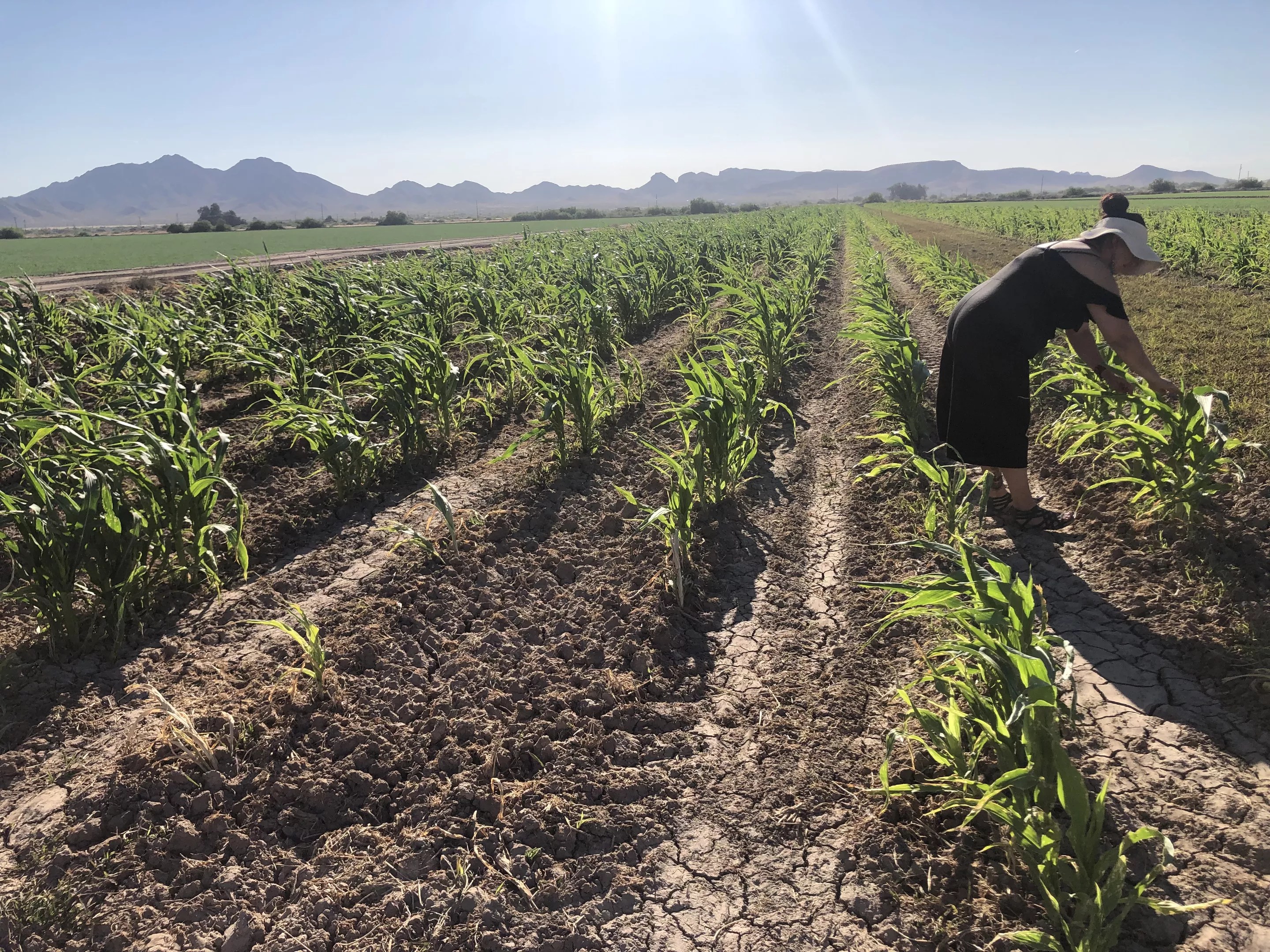
Chris Malloy

Audio By Carbonatix
Welcome to Sonoran Arcana, a column seeking to probe the margins of Arizona cuisine and define a more specific, novel cuisine that has emerged in America’s great Sonoran Desert: New Arizonan. Here, we will venture into the arid wilds and culinary unknown to spotlight the chefs and foragers, the millers and brewers, the miso masters and palo verde pod-pickers who are pioneering New Arizonan cuisine, or simply rocking out the food of Arizona. So throw open the doors to your mind and enjoy.
Velvet Button starts to leave the garbanzo field. She stops on the edge and plucks a pod from a low plant, similar to all the others in the yellow rows around her. The lumpy pod looks about as moist as a ruffled potato chip. Velvet rolls the pod between her fingers. It crushes to dust, blows away. Parched garbanzos remain, jewels of the low field drying before harvest.
Beneath Velvet’s strappy sandals, the soil is fabulously cracked.
Cracked like thin ice on a pond – only there won’t be ice anywhere on this June day. The heat is well on its way to triple digits. Velvet’s father, Terry Button, has long been at work with his team of farmers, battling the wind to bale hay since 2 a.m. Roadrunners glide the dirt and paved pathways between Ramona Farms’ 4,000 acres, disconnected and scattered over 27 miles. Hawks circle above mesquite trees, a coyote lopes through a barley field, and colorful corn blows in the wind.
This year, make your gift count –
Invest in local news that matters.
Our work is funded by readers like you who make voluntary gifts because they value our work and want to see it continue. Make a contribution today to help us reach our $30,000 goal!
Standing tall above a withered garbanzo plant, Velvet says the legumes are field-dried, just like her family’s tepary beans. Founded on 10 acres of Gila River Indian Community land in 1974 by Terry Button and Ramona Button (Velvet’s mom), Ramona Farms is best known for its prodigious efforts to restore the tepary bean to cultivation.
In the mid-1970s, Ramona and Terry found a jar of the drought-resistant, virtually extinct Sonoran beans in her late father’s truck – and started planting. Within a few long years, they were selling teparies by the 100-pound gunnysack. (Velvet’s maternal grandfather was Tohono O’odham and his wife was Akimel O’odham. She identifies as both, but is officially registered as the latter.)
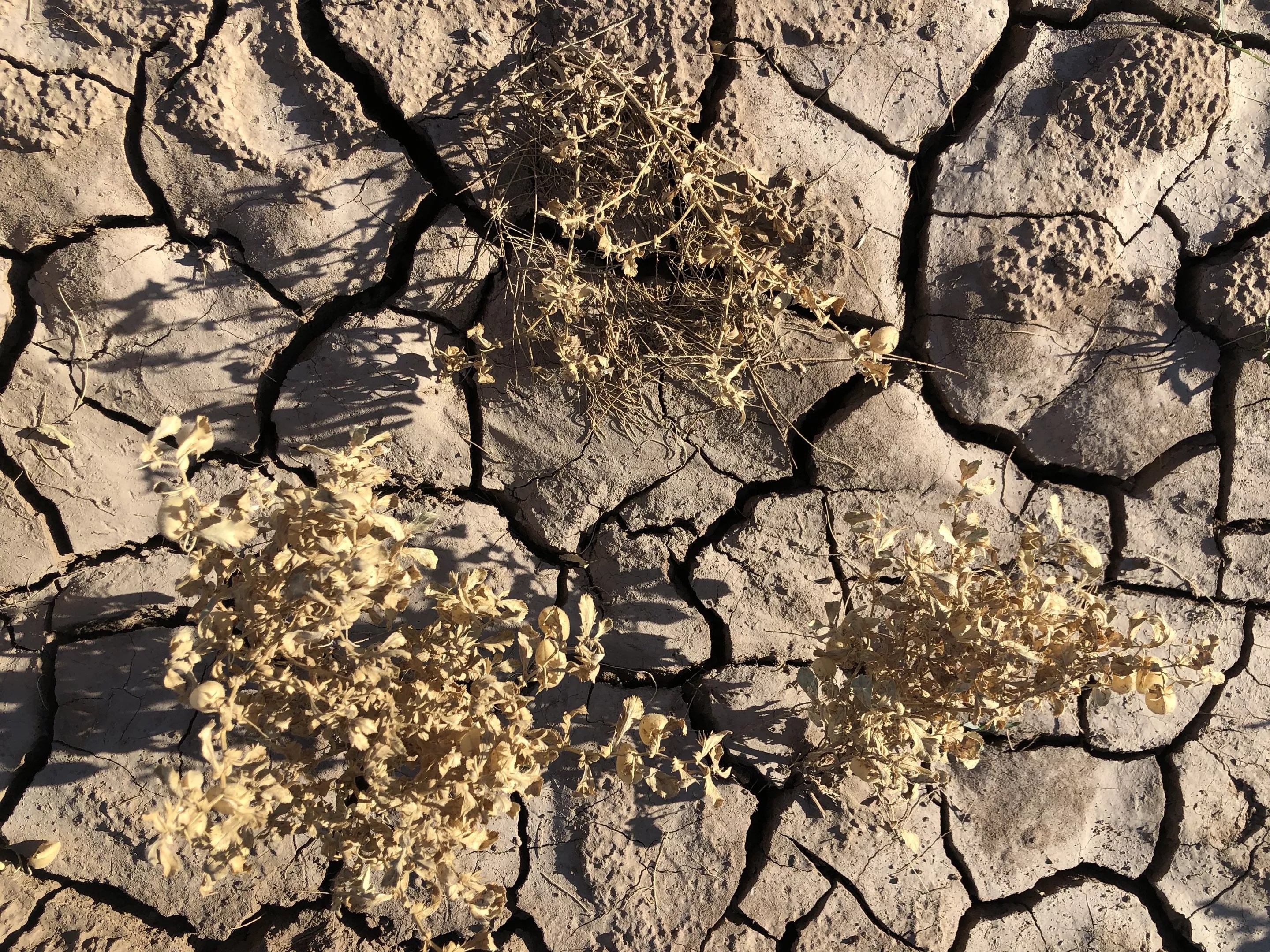
The cracked soil of a field of garbanzo plants, drying before harvest.
Chris Malloy
Dry climate. Modest water. Robust flavor. The story of the tepary is known in these parts. But on the family farm in the Gila River Indian Community, the Buttons also raise other crops once grown by local tribes, especially by their own Akimel O’odham, formerly called Pima. They grow two heritage wheats, plus a third, durum, and four corn varietals cultivated in the dry Southwest since ancient times. Not to mention common wheat, barley, sorghum, cotton, Bermuda grass, alfalfa, and more.
The Buttons supply crops to their reservation, to regional chefs, and, through their website, to the world. The organic section of their farm – where their heritage crops grow – is the kind of food source with the capacity to change eating in greater Phoenix.
Instead of making tamales and polenta with yellow stuff from afar, cooks could channel the flavors and integrity of the local land using Ramona Farms’ Hopi blue, Hotevilla pink, Havasupai red, or 60-day Pima corn. Teparies could substitute for other beans with less flavor, less history, and a larger carbon footprint. In a region with limited water and a meager 3 to 20 inches of precipitation a year, teparies can thrive in the desert summer on a single rainfall.
And these properties will make teparies more important as the Colorado River water supply continues to thin, the planet warms, and the Southwest gets hotter and drier.
Just a short drive from metro Phoenix, in a part of the Gila River Valley where the river has dried up because of upstream human diversion, the Buttons keep Ramona Farms with spartan rigor and boundless love. Here are ancient, modern crops that are made for their environment – and taste great. And yet, only a handful of eateries in the Phoenix area use them.

Cotton & Copper serves a Ramona Farms tepary bean spread.
Jackie Mercandetti
Some of their chefs visit – to see the indigenous crops, to see the deeply cracked garbanzo field.
“We didn’t do anything to amend the soil other than rotate our crops, and just manage through careful watering and whatnot,” Velvet says, wind whispering in the dry plants, part of the 200 acres of USDA-certified organic land where the Buttons grow their premier crops. “We don’t use organic fertilizers. We don’t use organic herbicides. We don’t use those because of those traditional reasons.”
“What are those traditional reasons?” I ask.
“We don’t put anything on our food,” she smiles. “We let the creator do that.”
Velvet trades the garbanzo fields for her car. She rumbles along a dirt lane along the field. Wild mint on the dash bakes in the sun, turns fragrant. As she makes for the next field, Velvet unpapers a breakfast of a biscuit and c’emet – the latter a flatbread cooked since the Spanish missionary Eusebio Francisco Kino brought grain to the region in the 1600s. Both c’emet and tortilla are stuffed with tepary beans and salsa. Both are made from Ramona Farms Pima wheat, a heritage grain.
Velvet herself doesn’t raise wheat. Her role on the farm and beyond is more culinary and educational. She is an exponent of Akimel O’odham crops and their applications, a proselytizer of tepary bean brownies and blue corn pancakes, not to mention the likes of wild wolfberries and early summer’s saguaro fruit. She is a teacher, cook, and free spirit. She is also, today and other days, a farm tour guide.
Driving, she points out an alfalfa field.
She talks about hospitals and canal projects, about local artist Amil Pedro and Akimel O’odham legend Chief Azul, the tribe’s last chief.
Soon, the low green shoots of a corn field show. Velvet parks. She walks into the rows of young plants. The machine-gun trilling of a killdeer is muffled by the vast chorus of crop leaves rustling. The field holds a Hopi blue corn varietal, still a few weeks from harvest.
Beyond this patch and flush with a crook in the road rises a comb-lined parcel of Pima 60-day corn, an Akimel O’odham mainstay known as kiikam huuñ. Sown to align with monsoon season, 60-day corn can pass from planting to harvest in that lightning time frame.
“When it’s grown in optimal temperatures, it’s gangbusters,” Velvet says. “That corn grows like crazy.”
Area chefs do many things with Ramona Farms corn. Tamara Stanger of Cotton & Copper uses it to bread chicken. Brett Vibber of Cartwright’s Modern Cuisine has sourced it as ga’ivsa, mesquite-roasted and cracked, and slurried it molten under wild Pacific salmon. Pueblo Vida, a brewery down in Tucson, uses Hotevilla pink corn in the crafting of Vida Beer, a “Southwestern premium” lager.
“The chefs that are choosing to put these foods on the menu are taking the time to understand the food, understand the people that domesticated this food and have kept it in production,” Velvet says. “It’s getting the respect it deserves, because they’re taking the time to really know it.”
Velvet herself has many uses for corn. She nixtamalizes corn using bean and wood ash. She makes tamales, porridges, mush, tortillas, corn c’emet, and other old and new preparations. She and her sister, Brandy Button, proudly work to adapt “traditional foods for the modern O’odham table.” On hot days, Velvet fortifies apple juice with huuñ haak chu’i, a roasted corn flour that messengers once packed under their lips before they ran from village to village.
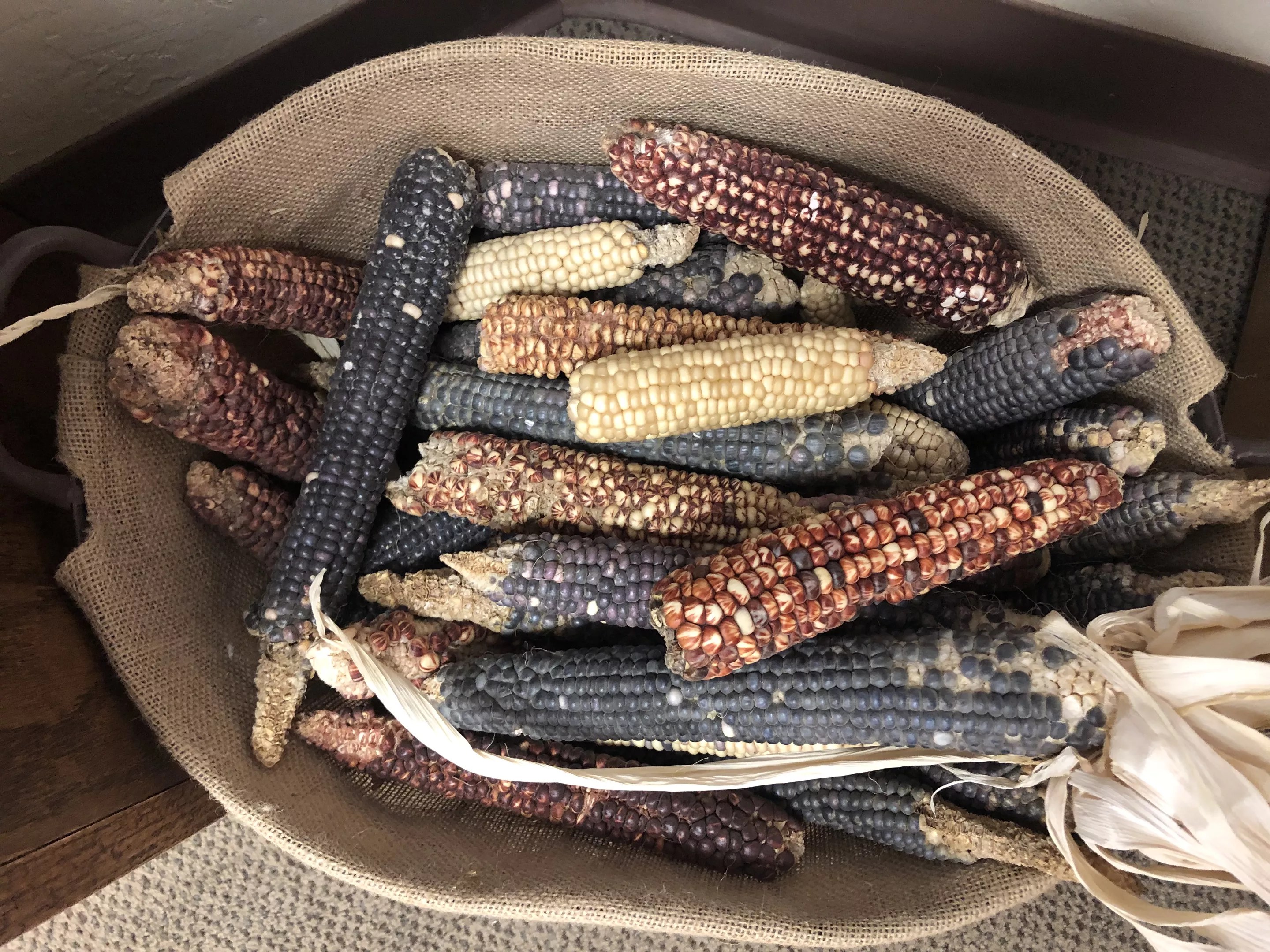
Four kinds of heritage corn bring four different colors.
Chris Malloy
Come each plot’s separate harvest, Ramona’s workers hand-pick corn. Ears are roasted out in the field, over mesquite fires. At intervals, broad empty lanes run between ruler-straight lines of tall green. These idle strips leave space for trucks, so local laborers can stow their just-picked bounty.
Before corn, this plot held barley. Ramona Farms is constantly cycling and rotating crops – to nurse the soil, to dovetail with the seasons. “There’s something planted or harvested every day of the year,” Velvet says.
She gets back into the car. A dirt road slithers ahead. The green acreage and blue sky in the low bowl of mountains slide by in a bucolic dream.
We pass concrete canals skirting fields. Ramona Farms uses flood irrigation, letting pumped groundwater course across fields, watering crops. This is possible because Velvet’s uncle painstakingly leveled fields using lasers. Land he has reshaped, Velvet says, “is flatter than a pool table.”
Velvet now parks at a golden wheat field. Ramona Farms cultivates Pima, durum, and White Sonora wheat. The young wheat riffles and rustles in the wind with a colossal stirring sound, giving the field the peaceful magic of a golden ocean. “All of our wheat products are whole-grain,” Velvet says, listening to the now-far, now-surrounding rustling. “There are parts of the wheat, the oil and the germ, that help us digest other parts and enzymes. We’re supposed to eat the whole thing.”
The heat is mounting, so Velvet makes for a plot of tepary beans. Ramona Farms is divided into dozens of plots that patch across the Gila River Valley like a scattered quilt.
When the Gila River Indian Community was created, land was doled out to families in 10-acre plots. In order to amass 4,000 acres, Ramona Farms had to buy and lease from hundreds of fellow Akimel O’odham and Maricopa, the two main tribes on the reservation, especially when you consider that many of these 10-acre plots were further divided through life, death, and smaller vicissitudes.
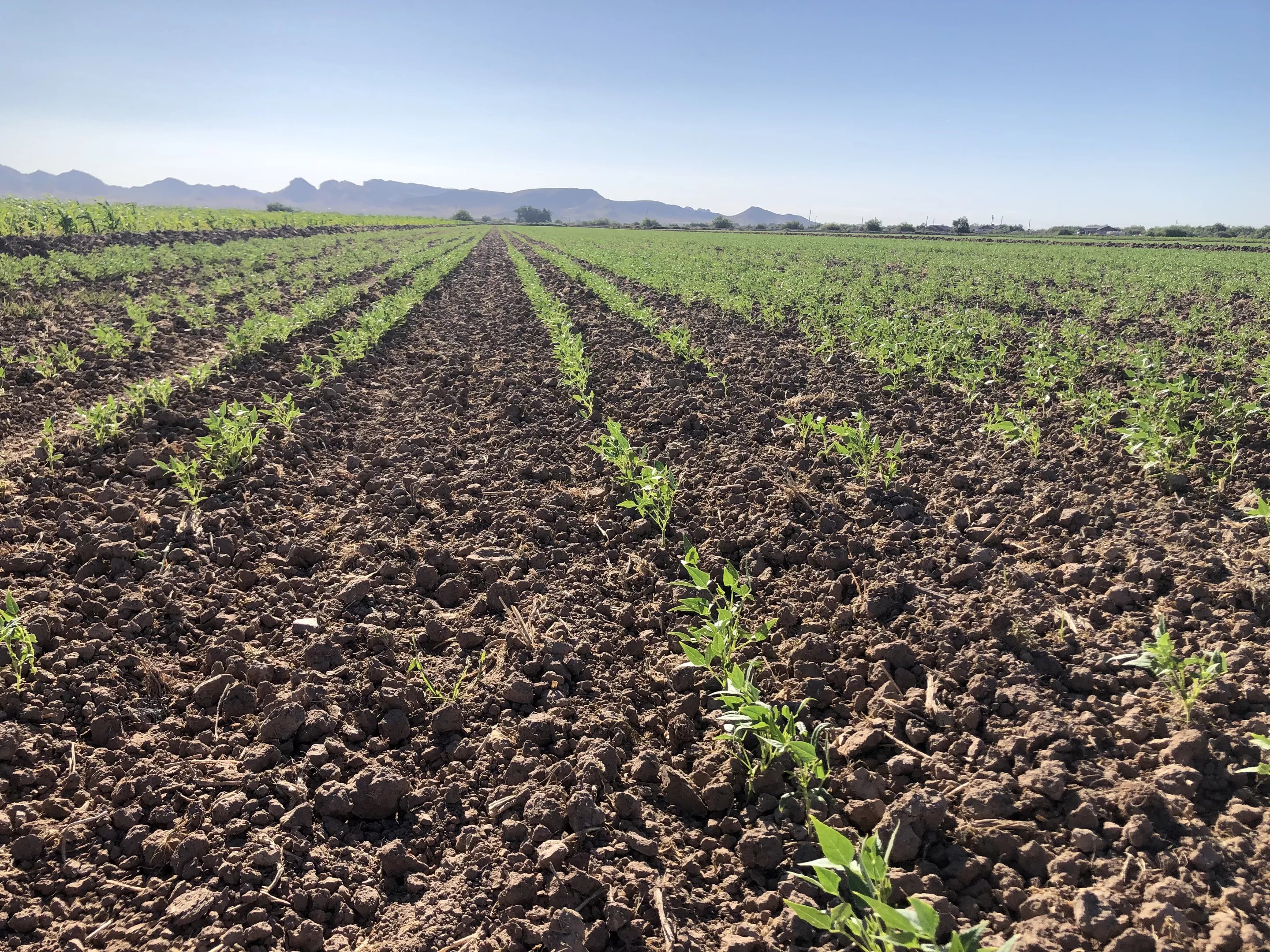
Rows of tepary beans pointing to eastern mountains.
Chris Malloy
The tepary beans were planted just a few weeks ago.
They are leafy, shifting shoots in clods of brown soil. They point at distant, sacred mountains. When the plants are ready for harvest, beans will be white, brown, and black.
White tepary beans, Velvet says, are “sweet and buttery” with “a smooth texture.”
Brown teparies are “nutty and earthy” with “a texture of boiled pecan.” They keep their shape when boiled. “In a nice brothy soup, they showcase like little river petals – they’re so pretty,” Velvet says. “And when you cook the brown tepary bean, oh my gosh, the kitchen smells like rain.”
Velvet’s parents bred the black tepary into existence. “They were created over a very careful hand selection over the last 30 years or so,” Velvet says. What they did was save black tepary beans that arose from the white and brown crops. When they had enough, they planted them.
You can order black (and other) teparies from the Ramona Farms website. It reads: “Firm textured and meaty flavored – the s-chuuk bavi is a special and very limited tepary variety.”
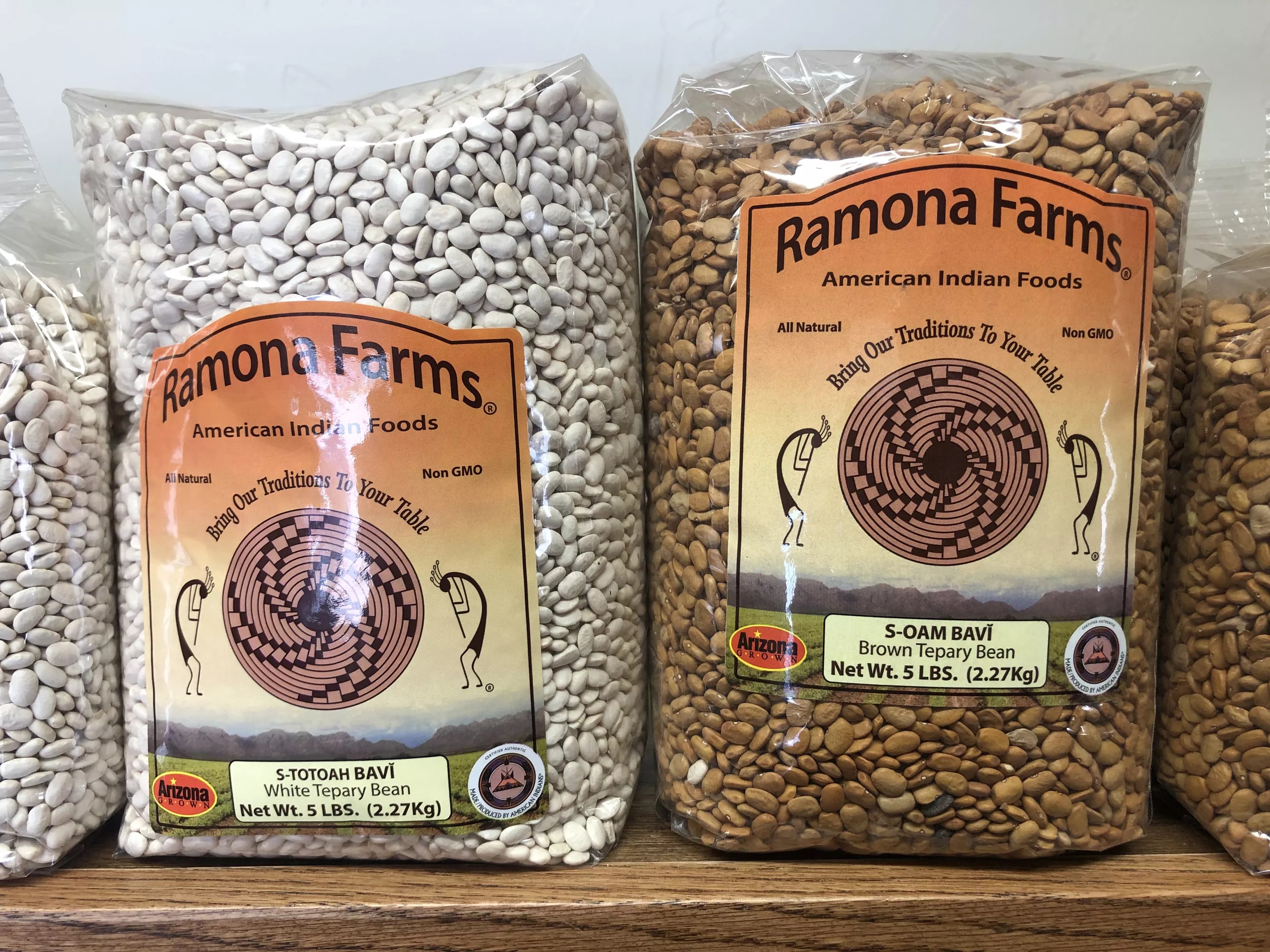
The original tepary varieties Ramona Farms started growing in the 1970s: white and brown.
Chris Malloy
Driving back to the farm store and offices (she proudly doesn’t have one), Velvet produces two brownies. These are tepary bean brownies, squares that use cooked beans and heritage flour to form the bulk of their substance. Often, she bakes them for students, part of her mission to educate about the foods of the past and give the next generation a taste for them. The brownies vibrate with a primal, earthy intensity. They have a complex sweetness, arisen not from sugar but desert-evolved beans.
Back in the farm center, Velvet’s mom, Ramona, sits at her desk.
She tells about the farm’s history, about the need to share ancient crops with upcoming generations. “We went from a clay pot to a Crock-Pot,” she laments. Her stories about speaking to horses in Akimel O’odham and spirits living in buried clay pots re-tilt your head, adjusting the way you see things.
“In order to die a happy death, you have to eat well,” she says, echoing words from her mother, a partially blind medicine woman, advice that inspired the farm’s founding. “Go back to the traditional values of the Pimas, and exercise more. Till your fields or your gardens. Sing a song and say your prayers.”
Note No. 1: On the Ramona Farms website, you can find information about the availability of crops, order them, find out where they can be bought at stores around metro Phoenix, find out which restaurants in Arizona and beyond use them, and learn some amazing recipes: O’odham grits, blue-corn pancakes, yeast-less biscuits, and, yes, tepary bean brownies.
Note No. 2: Kai Restaurant will be hosting a five-course dinner in collaboration with Ramona Farms on July 5, 2019. It will spotlight Ramona Farms ingredients like tepary beans, ga’ivsa, and pinole.